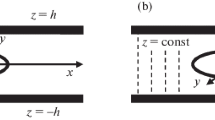Abstract
We propose a method for the analysis of the limiting state of transversely isotropic plates with surface and internal cracks and obtain a new simple approximate formula for the evaluation of the stress intensity factors. The numerical calculations are based on the improved version of the analysis of stress-strain states in defect-free transversely isotropic plates. The failure is initiated as soon the damage ratio near the crack front in the direction of crack propagation attains a certain critical value.
Similar content being viewed by others
References
V. V. Panasyuk, Mechanics of Quasibrittle Failure of Materials [in Russian], Naukova Dumka, Kiev (1991).
V. V. Panasyuk, A. E. Andreikiv, and V. Z. Parton, Foundations of the Fracture Mechanics of Materials [in Russian], Naukova Dumka, Kiev (1988).
L. T. Berezhnitskii, M. V. Delyavskii, and V. V. Panasyuk, Bending of Thin Plates with Cracklike Defects [in Russian], Naukova Dumka, Kiev (1979).
S. V. Serensen and G. P. Zaitsev, LoadBearing Ability of ThinWalled Structures Made of Reinforced Plastics with Defects [in Russian], Naukova Dumka, Kiev (1982).
V. V. Bozhydarnyk and H. T. Sulym, “Fracture criterion for anisotropic plates,” Visn. Ternop. Tekhn. Univ., 5, No. 3, 12–19 (2000).
V. V. Bozhydarnyk and H. T. Sulym, “Fracture of plates with high degrees of anisotropy,” Mashynoznavstvo, No. 11, 3–8 (2000).
O. I. Balyts'kyi, New Materials for HighPower Turbogenerators [in Ukrainian], Karpenko Physicomechanical Institute, Ukrainian Academy of Sciences, Lviv (1999).
S. Ya. Yarema and G. S. Krestin, “Distribution of stresses near the crack tip in an anisotropic plate,” Fiz.Khim. Mekh. Mater., 5, No. 6, 714–719 (1969).
G. P. Cherepanov, Mechanics of Brittle Failure [in Russian], Nauka, Moscow (1974).
V. V. Bozhydarnyk, TwoDimensional Problems of the Theory of Elasticity and Thermoelasticity for Structurally Inhomogeneous Bodies [in Ukrainian], Svit, Lviv (1998).
M. P. Savruk, Stress Intensity Factors in Bodies with Cracks [in Russian], Naukova Dumka, Kiev (1988).
Yu. Murakami (editor), Stress Intensity Factors. Handbook, Pergamon Press, Oxford (1987).
J. C. Newman and I. S. Raju, “An empirical stress intensity factor equation for the surface crack,” Int. J. Fract. Mech., 15, No. 1/2, 185–192 (1981).
A. E. Andreikiv and A. I. Darchuk, Fatigue Fracture and Durability of Structures [in Russian], Naukova Dumka, Kiev (1992).
B. F. Vlasov, “On a special case of bending of a rectangular thick plate,” Vestn. Mosk. Univ., Ser. Mat., Mekh., Astr., Fiz., Khim., No. 2, 25–34 (1957).
Author information
Authors and Affiliations
Rights and permissions
About this article
Cite this article
Bozhydarnyk, V.V., Sulym, H.T. Limiting State of Transversely Isotropic Plates with Surface and Internal Cracks. Materials Science 37, 598–609 (2001). https://doi.org/10.1023/A:1013220704256
Issue Date:
DOI: https://doi.org/10.1023/A:1013220704256




